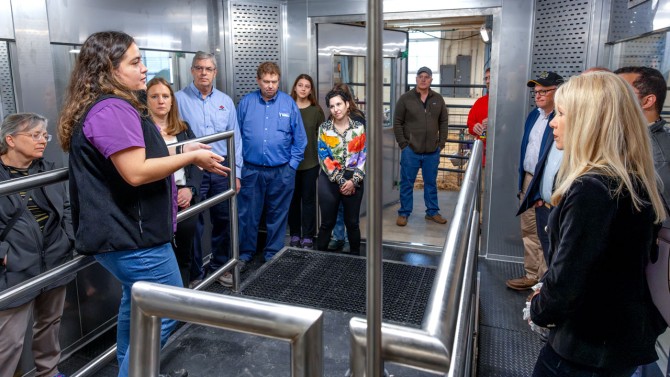Thanks to partnerships with industry, government and New York farmers, Cornell's Department of Animal Science is now home to new, state-of-the-art animal respiration stalls that will enable research on livestock feed, health and climate impacts. The facility is the first of its kind in the U.S.
Cornell researchers and administrators celebrated the facility with a ribbon-cutting ceremony April 18, alongside partners from Cargill, the Genesee Valley Regional Market Authority, Balchem Corporation and the New York State Department of Agriculture and Markets.
"This facility typifies our land-grant mission by creating a novel, transdisciplinary meeting-ground where researchers and community partners can work together to solve major challenges," said Benjamin Houlton, the Ronald P. Lynch Dean of Cornell's College of Agriculture and Life Sciences. "These animal respiration measurements will accelerate livestock innovations for sustainability, both locally and around the world, and we're so grateful to our New York state and industry partners for their continued support of this important project."
The new Cornell University Animal Respiration Chambers are individual, climate-controlled rooms made of stainless steel with glass windows. Researchers will use the new facilities to understand how much greenhouse gas livestock produce and what management techniques could reduce those climate-warming gases. Livestock emit methane, which is the second largest contributor to global warming, after carbon dioxide. Among other initiatives, researchers will test changes in livestock diets with the goal of optimizing nutrition for efficient milk and meat production, enhanced animal health and minimum greenhouse-gas production. Joseph McFadden, associate professor of animal science, spearheaded the effort to install the facility.
"With this technology, we'll be able to more accurately answer questions about how livestock contribute to climate change and more effectively test strategies to reduce those impacts," McFadden said. "The overall goal is to optimize meat and milk production, ensure animal health and welfare, and minimize greenhouse-gas emissions and nutrient waste."
The animal respiration facility was funded in part by a capital grant from the New York State Department of Agriculture and Markets, and Deputy Commissioner Elizabeth Wolters attended the ribbon-cutting. Commissioner Richard Ball praised the cooperative partnership that made the facility possible.
Ananda Portela Fontoura, postdoctoral associate in the Department of Animal Science, leads a tour of the new cow methane measurement facility.
"New York state is proud to have a nation-leading climate agenda, and as part of that we're committed to assisting our farmers as they work to reduce methane emissions on their farms," Ball said. "Cornell's new respiration chambers are going to be a critical piece of that effort, enabling researchers to conduct state-of-the-art experiments in highly controlled environments to understand how animals respond to diet changes. The results from this work will help our agricultural community better understand how to care for their animals while still ensuring that they can produce the local, nutritious foods that our communities rely on."
The Genesee Valley Regional Market Authority (GVRMA), a New York state public authority that serves farmers in nine counties in western New York, was an early supporter of the new facility. Dairy farmers care deeply about providing nutritious food for their communities and about protecting the environment for future generations, said Brendan Tydings, the GVRMA administrator. The industry group U.S. Dairy has set a goal for the national dairy community's carbon footprint to be net zero by 2050.
"Everyone realizes the importance of this, but how do you carry it out and get it done? That's why the types of studies Professor McFadden will be doing in this new facility are so important, to provide substance to these somewhat lofty goals, to show where we need to prioritize our time and energy to make it realistic," Tydings said. "This is going to provide a resource for our dairy farmers to test and to evaluate what they're doing going forward so they can continue to improve."
Read the full story at the CALS website.
Krisy Gashler is a writer for the College of Agriculture and Life Sciences.








